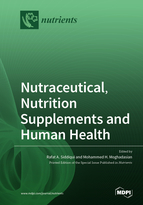Nutraceutical, Nutrition Supplements and Human Health
A special issue of Nutrients (ISSN 2072-6643).
Deadline for manuscript submissions: closed (31 October 2019) | Viewed by 138971
Special Issue Editors
Interests: role of polyphenols and lipids in cancer; inflammation; obesity; cardiovascular diseases; synergistic modulation of chronic diseases by a combination of nutrients and drugs
Special Issues, Collections and Topics in MDPI journals
2. Canadian Center for Agri-food Research in Health and Medicine, St. Boniface Hospital Research Center, Winnipeg, MB R2H 2A6, Canada
Interests: functional foods and nutraceuticals; metabolic disorders; diet and drug interactions; lipid nutrition and metabolism; nutrition through the life cycle; lipoprotein metabolism; atherosclerosis
Special Issues, Collections and Topics in MDPI journals
Special Issue Information
Dear Colleagues,
The term “nutraceuticals” is derived from “nutrition” and “pharmaceuticals” and used for nutrition products that are also used as medicine. “Nutraceuticals” often contain modified/unmodified whole food, plant extracts alone or in combination, semi-purified and purified phytochemicals, or a combination of different phytochemicals. On the other hand, nutritional supplements are nutritional compounds that supplement one’s diet by increasing one’s total daily intake. Nutritional supplements also contain substances alone or in combination with vitamins and minerals, with or without other herbal products. The interest in nutraceuticals is growing, as these products are often used for preventing chronic diseases, delaying the ageing process, improving one’s bodily structure, and increasing life expectancy. These are often perceived as “safe” and less likely to have side effects. However, scientific research on nutraceuticals and nutrition supplements is frequently misinterpreted or overstretched for commercial interests because of high consumer demand. The purpose of this Special Issue on “Nutraceuticals, Nutrition Supplements, and Human Health” is to comprehensively review the data from basic and clinical research to discuss the benefits as well as potential adverse effects. We invite authors to submit original research and review articles that address the progress and our current understanding of nutraceuticals/supplements from in vitro and in vivo studies, as well as from clinical trials describing the benefits/adverse effects with underlying mechanisms. Topics are desired focusing on nutraceuticals/supplements analysis, intake, absorption and metabolism, cell signaling, gene expression, and variation in cellular effects due to gene polymorphisms. The overall goal of this Special Issue is to present readers with high-quality scientific evidence for the use of dietary supplements, nutraceuticals, and functional foods that can be properly used to improve health parameters in the various stages of one’s lifecycle.
Prof. Dr. Rafat A. Siddiqui
Prof. Dr. Mohammed Moghadasian
Guest Editors
Manuscript Submission Information
Manuscripts should be submitted online at www.mdpi.com by registering and logging in to this website. Once you are registered, click here to go to the submission form. Manuscripts can be submitted until the deadline. All submissions that pass pre-check are peer-reviewed. Accepted papers will be published continuously in the journal (as soon as accepted) and will be listed together on the special issue website. Research articles, review articles as well as short communications are invited. For planned papers, a title and short abstract (about 100 words) can be sent to the Editorial Office for announcement on this website.
Submitted manuscripts should not have been published previously, nor be under consideration for publication elsewhere (except conference proceedings papers). All manuscripts are thoroughly refereed through a single-blind peer-review process. A guide for authors and other relevant information for submission of manuscripts is available on the Instructions for Authors page. Nutrients is an international peer-reviewed open access semimonthly journal published by MDPI.
Please visit the Instructions for Authors page before submitting a manuscript. The Article Processing Charge (APC) for publication in this open access journal is 2900 CHF (Swiss Francs). Submitted papers should be well formatted and use good English. Authors may use MDPI's English editing service prior to publication or during author revisions.
Keywords
- Functional foods
- Nutraceuticals
- Dietary supplements
- Chronic diseases
- Health
- Clinical trials
- Animal studies








